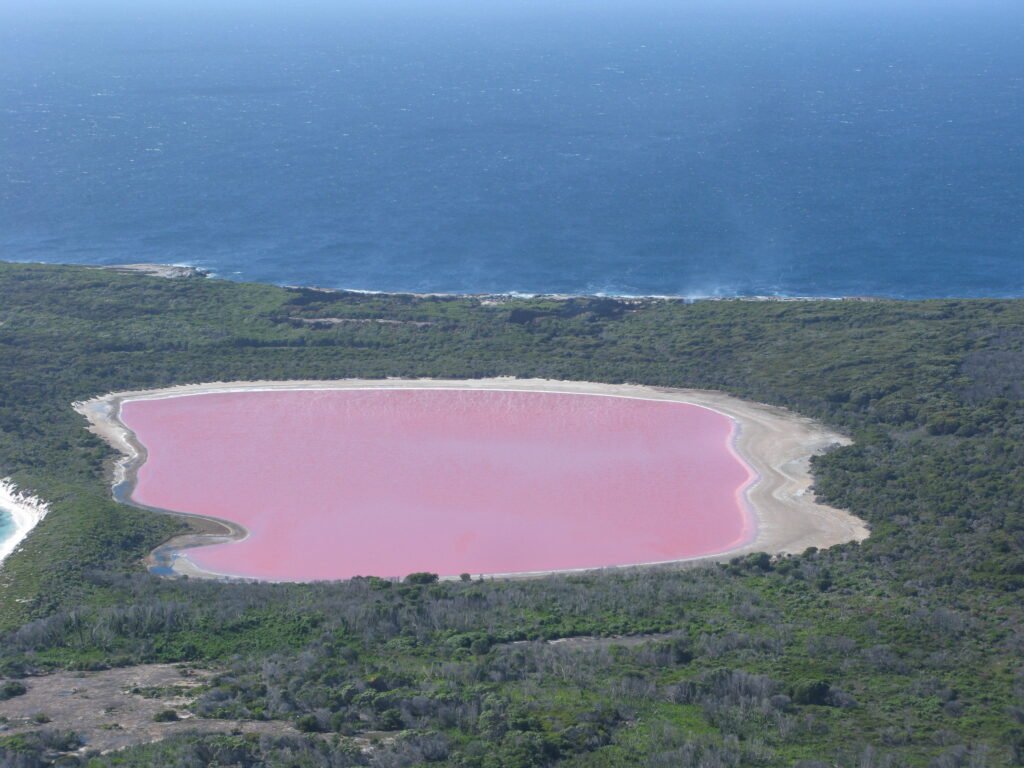Imagine stumbling upon a lake that looks like someone poured an enormous milkshake across the Australian landscape. Lake Hillier sits on Middle Island, off Western Australia’s coast, and its cotton-candy pink waters have been baffling scientists and mesmerizing visitors for over two centuries. This isn’t some Instagram filter gone wild or a chemical spill waiting to be cleaned up. This is Mother Nature showing off her most eccentric side, creating a phenomenon so bizarre that even today’s advanced scientific methods can’t fully explain why this lake maintains its shocking pink hue year-round.
The lake’s discovery reads like something from an explorer’s fever dream, yet it’s completely real and continues to challenge our understanding of natural water chemistry. What makes this 600-meter-long stretch of water glow like a neon sign in the middle of pristine wilderness? The answer isn’t as simple as you might think.
The Discovery That Left Explorers Speechless
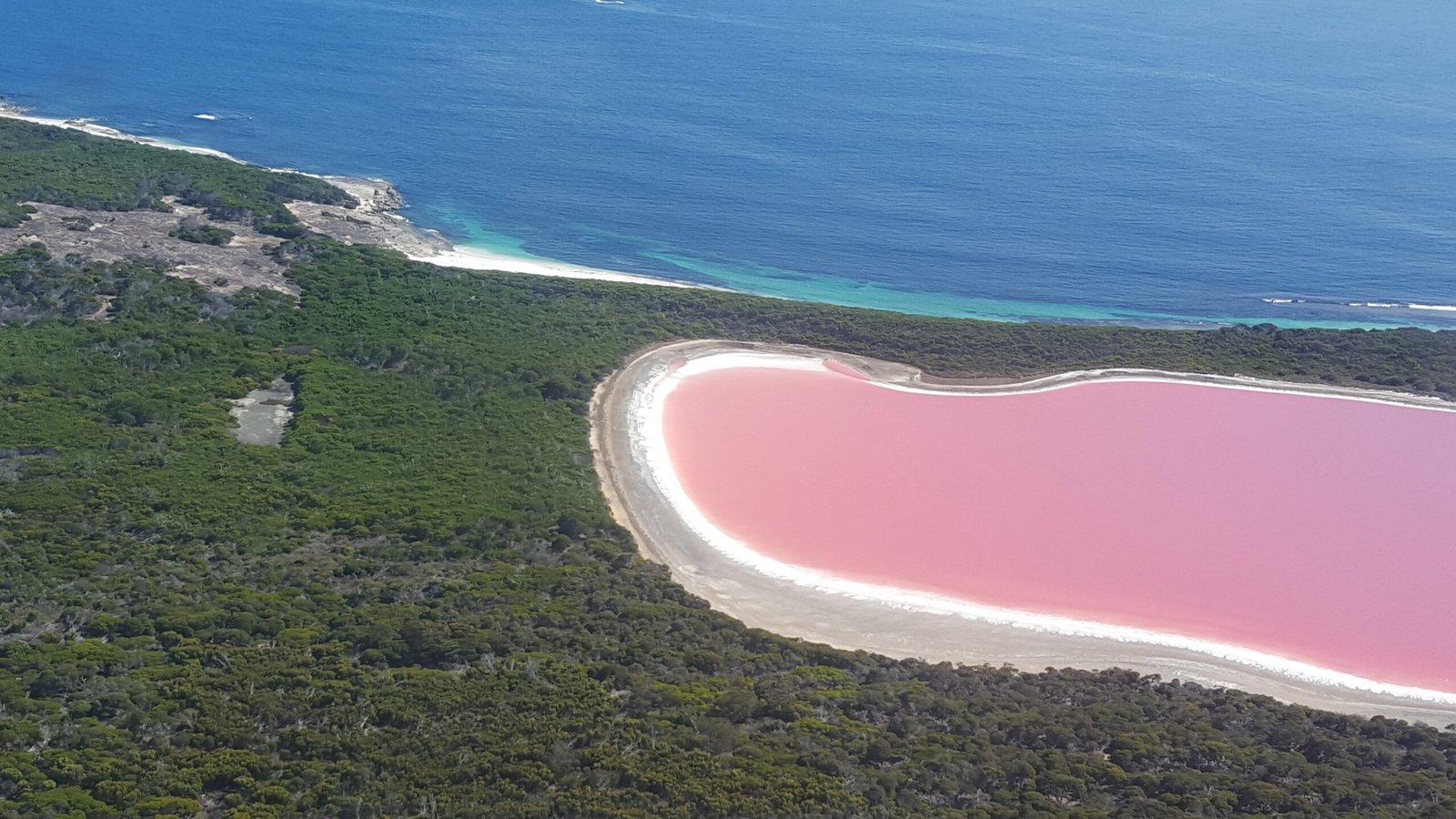
Back in 1802, British navigator Matthew Flinders was mapping Australia’s southern coast when he spotted something that made him question his own eyesight. From his ship’s deck, he observed what appeared to be a massive pink puddle nestled among the green eucalyptus trees of Middle Island. Flinders documented this strange sight in his journals, but his descriptions were so outlandish that many back in England dismissed them as the hallucinations of a sun-addled sailor.
The indigenous Noongar people of the region had known about this pink wonder for thousands of years, weaving it into their oral traditions as a sacred site. They called it a place where the spirits painted the water with the colors of sunset. Little did they know that their ancestral stories would one day intersect with cutting-edge microbiology in ways that would boggle the scientific community.
What’s truly remarkable is that Flinders’ initial observations remain just as accurate today as they were over 220 years ago. The lake hasn’t faded, changed color, or lost its vibrancy despite centuries of exposure to harsh Australian weather conditions.
A Geographic Anomaly in Paradise
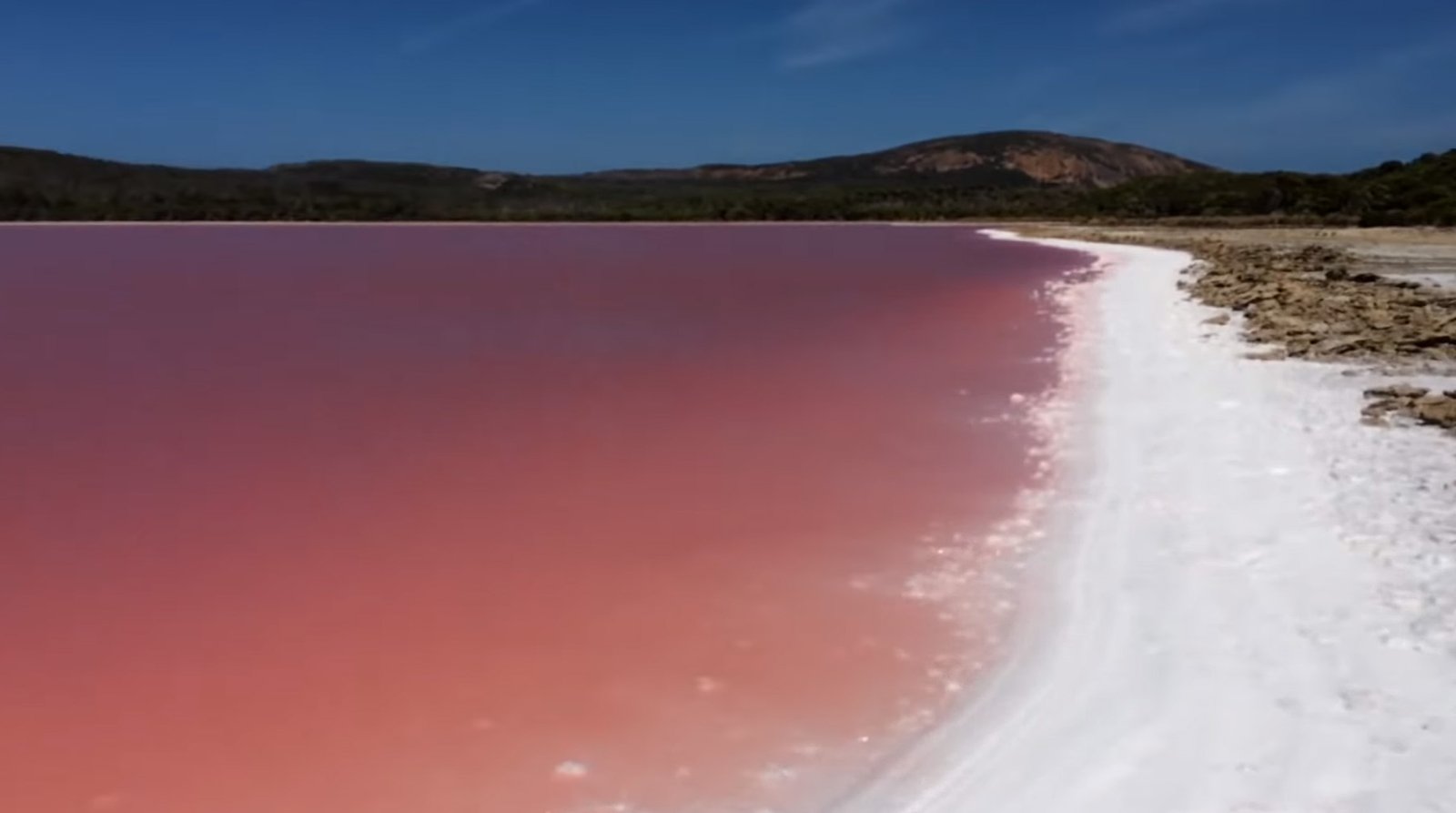
Lake Hillier sits like a pink jewel on Middle Island, part of the Recherche Archipelago about 130 kilometers southeast of Esperance. The island itself is a nature reserve, meaning this colorful curiosity exists in one of Australia’s most pristine environments. The lake measures roughly 600 meters long and 250 meters wide, making it substantial enough to be visible from aircraft flying at commercial altitudes.
What makes this location even more extraordinary is its proximity to the Southern Ocean. The lake sits just meters away from the deep blue waters of the ocean, separated only by a thin strip of sand and vegetation. This creates one of nature’s most striking color contrasts – imagine standing on a beach where bubblegum-pink water laps at white sand on one side, while deep ocean blue stretches to the horizon on the other.
The surrounding landscape adds another layer of surreal beauty to this already mind-bending scene. Dense eucalyptus forests frame the pink waters, their green canopies providing a natural border that makes the lake’s color appear even more vivid and otherworldly.
The Science Behind the Shocking Pink
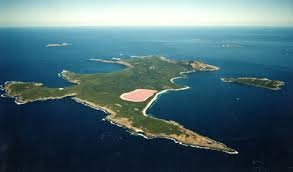
Scientists have been scratching their heads over Lake Hillier’s persistent pink color for decades, and the explanations they’ve uncovered read like a microbiology textbook come to life. The leading theory centers around a cocktail of microorganisms that thrive in the lake’s extremely salty conditions. These aren’t your garden-variety bacteria – they’re extremophiles, organisms that flourish in environments that would kill most other life forms.
The primary suspect is a type of bacteria called Salinibacter ruber, which produces pink and red pigments as a natural sunscreen to protect itself from intense ultraviolet radiation. Think of it as nature’s SPF 50, except instead of white zinc cream, these microscopic organisms coat themselves in vibrant pink compounds called carotenoids.
But here’s where it gets really interesting – the exact combination of factors that maintains Lake Hillier’s color remains partially mysterious. Other pink lakes around the world can change color with seasons, temperature, or rainfall, yet Lake Hillier maintains its shocking hue regardless of weather conditions or time of year.
Salt Levels That Would Make the Dead Sea Jealous
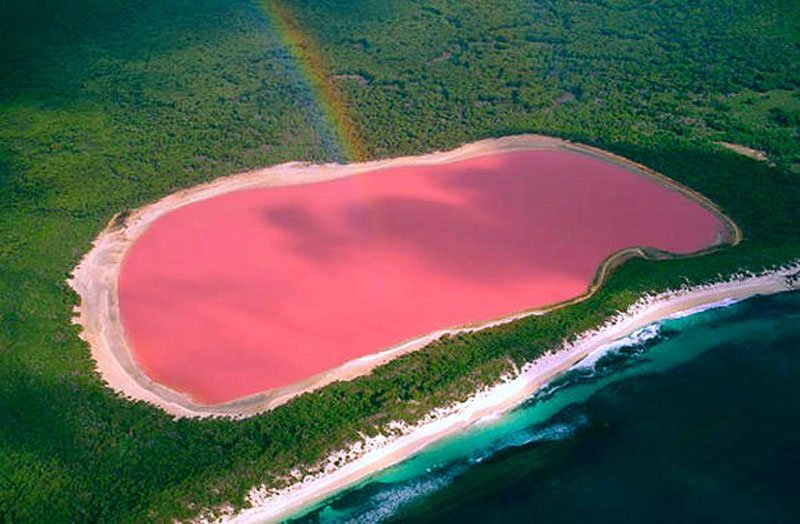
Lake Hillier’s salinity levels are absolutely staggering – we’re talking about water that’s saltier than the Dead Sea. The salt concentration reaches around 340 grams per liter, which is roughly ten times saltier than typical seawater. To put this in perspective, if you tried to swim in Lake Hillier, you’d float like a cork due to the incredible density of the water.
This extreme salinity creates a hostile environment where only the most specialized organisms can survive. Regular fish, plants, and most bacteria would be instantly killed by these conditions. It’s essentially an aquatic desert where only the toughest microbial survivors can call home.
The salt doesn’t just contribute to the lake’s unique ecosystem – it also plays a crucial role in maintaining the water’s pink color. The high salinity concentrates the pigment-producing bacteria, creating a more intense color saturation that remains stable throughout the year.
Microorganisms Living in Liquid Fire
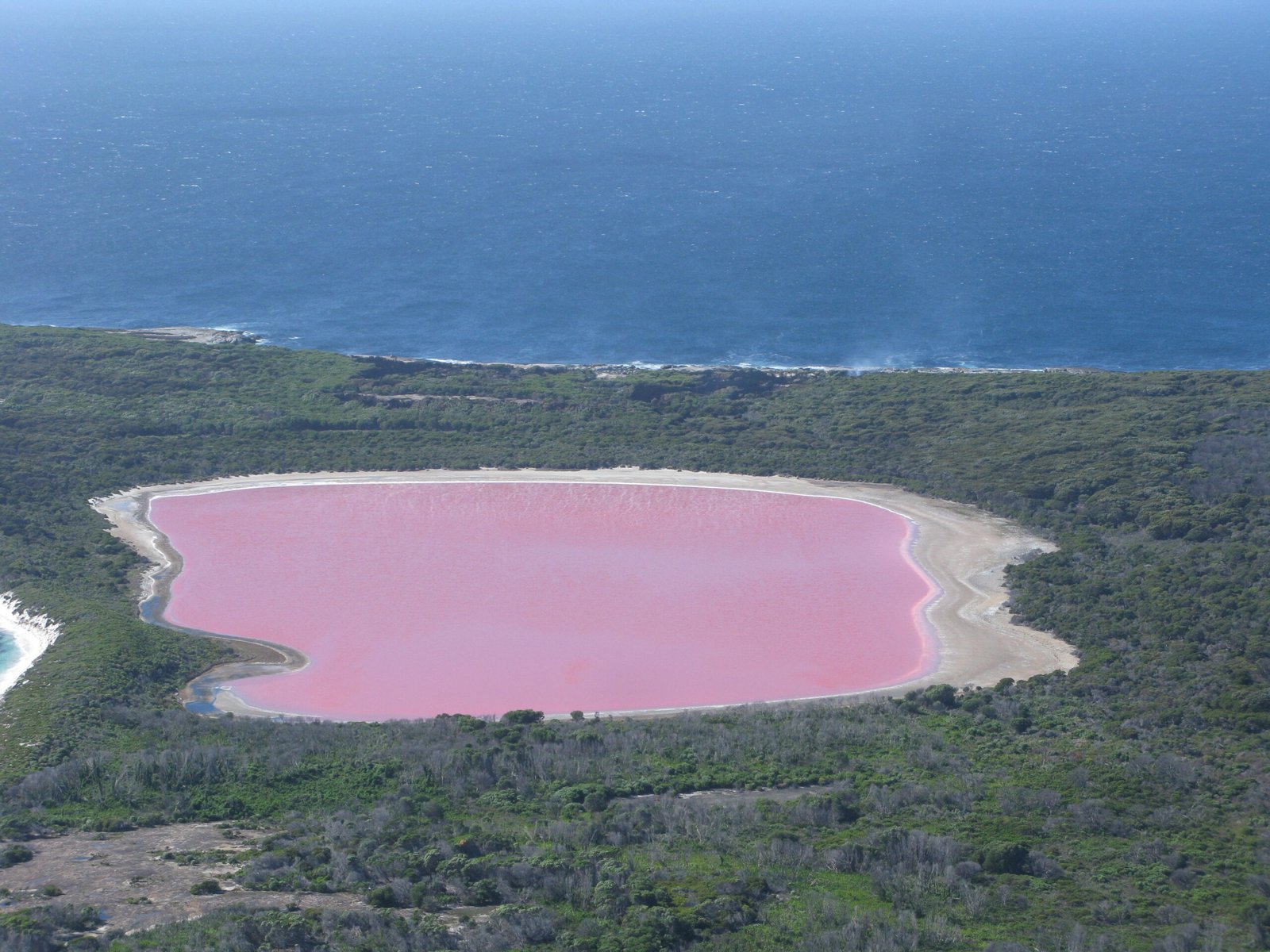
The microscopic residents of Lake Hillier are some of the most hardcore organisms on Earth. These extremophile bacteria don’t just survive in conditions that would instantly kill most life forms – they actually thrive in them. The primary color contributors include Dunaliella salina, a type of algae that turns bright red when stressed by high salt concentrations, and various species of halophilic (salt-loving) archaea.
These organisms have evolved incredible survival mechanisms that read like science fiction. They can regulate their internal salt concentrations, produce protective pigments, and even repair DNA damage caused by intense UV radiation reflected off the lake’s surface. It’s like having a microscopic city populated entirely by superheroes with very specific superpowers.
What’s fascinating is that these same organisms are found in other extreme environments around the world, from salt flats in Chile to underground salt mines. Yet somehow, the specific combination and concentration in Lake Hillier creates this unique, stable pink coloration that other locations can’t replicate.
The Mystery of Year-Round Consistency
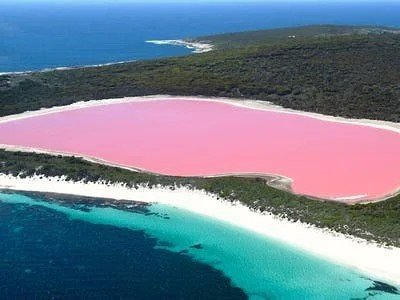
Here’s what really stumps scientists: Lake Hillier never changes color. Most other pink lakes around the world are seasonal performers, shifting from clear to pink to red depending on temperature, rainfall, and algae bloom cycles. Lake Hillier laughs in the face of seasonal changes and maintains its bubblegum-pink appearance 365 days a year.
Researchers have monitored the lake through scorching Australian summers and mild winters, during drought periods and heavy rains, yet the color remains remarkably stable. This consistency suggests that whatever biological and chemical processes are occurring in the lake have reached a perfect equilibrium that resists external disruptions.
Some scientists theorize that the lake’s isolation and unique microclimate create a self-regulating system. The surrounding vegetation, the nearby ocean, and the specific mineral composition of the lake bed might all contribute to maintaining this delicate balance that keeps the pink show running year-round.
Comparing Lake Hillier to Other Pink Lakes Worldwide

Lake Hillier isn’t the only pink lake on Earth, but it’s definitely the most reliable performer in this exclusive club. Australia alone has several other pink lakes, including the Hutt Lagoon in Western Australia and the Pink Lakes near Murray-Sunset National Park in Victoria. However, these other lakes are notorious for their color-changing moods, sometimes appearing brilliant pink and other times looking disappointingly ordinary.
Spain’s Laguna Salada de Torrevieja and Iran’s Lake Urmia also sport pink hues, but they’re highly dependent on seasonal conditions. During dry periods, they can glow like neon signs, but heavy rains often dilute their colors to pale pink or even muddy brown. Lake Hillier stands alone in its unwavering commitment to being fabulous.
What sets Lake Hillier apart isn’t just its consistency, but also its intensity. Many pink lakes appear more salmon-colored or light rose, but Lake Hillier’s water looks like someone mixed strawberry milk with highlighter ink. It’s this bold, unapologetic pinkness that makes it a true natural wonder.
The Role of Climate in Maintaining the Pink Phenomenon
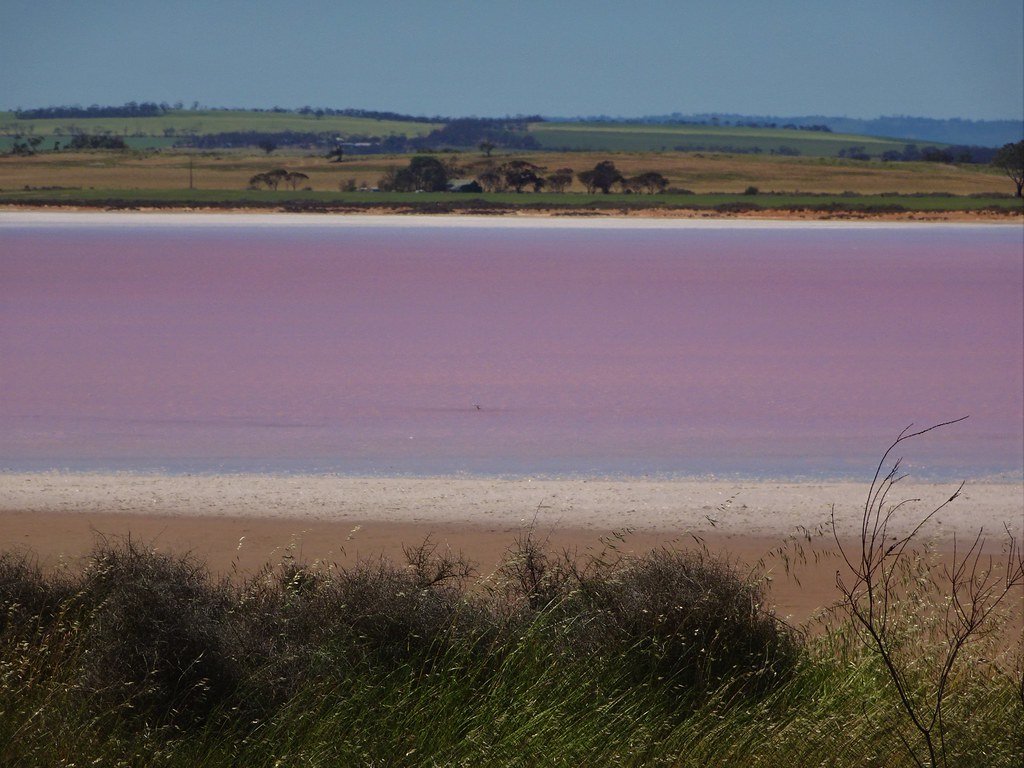
Western Australia’s Mediterranean climate plays a crucial role in Lake Hillier’s pink stability. The region experiences hot, dry summers and mild, wet winters – conditions that create the perfect environment for the lake’s unique ecosystem to flourish. The intense summer sun provides energy for photosynthetic organisms while also creating the UV stress that triggers protective pigment production.
The relatively low rainfall in the region means the lake doesn’t get diluted by frequent freshwater inputs that might disrupt its delicate chemical balance. When rain does occur, it’s usually not enough to significantly alter the lake’s salinity or disturb the established microbial communities that create the pink coloration.
Ocean proximity also influences the lake’s climate, providing moisture and moderating temperature extremes. This creates a stable microenvironment where the pink-producing organisms can maintain their populations without dramatic boom-and-bust cycles that might affect the water’s color.
Chemical Composition That Defies Normal Water Chemistry

Lake Hillier’s water chemistry reads like a recipe from an alien cookbook. Beyond the extreme salt content, the water contains high concentrations of magnesium, calcium, and potassium – minerals that create a chemical environment unlike anywhere else on Earth. These dissolved minerals don’t just contribute to the lake’s unique properties; they also influence which organisms can survive in this aquatic extreme sports arena.
The pH levels in Lake Hillier hover around 7.5 to 8, making it slightly alkaline – another factor that helps maintain the stability of the pink-producing organisms. This chemical cocktail creates conditions where normal freshwater life forms would instantly perish, while the specialized pink-pigment producers thrive like they’ve found their perfect home.
What’s particularly intriguing is that despite these extreme conditions, the water remains crystal clear. You’d expect such a highly mineralized, biologically active body of water to be cloudy or murky, but Lake Hillier’s transparency allows you to see straight to the bottom through that shocking pink medium.
The Evolutionary Marvel of Pink-Producing Bacteria

The bacteria responsible for Lake Hillier’s color are evolutionary marvels that have spent millions of years perfecting their survival strategies. These organisms represent some of Earth’s oldest life forms, descendants of bacteria that first appeared when our planet’s atmosphere contained virtually no oxygen. They’ve essentially remained unchanged for eons, making Lake Hillier a living museum of ancient life.
The pink pigments these bacteria produce aren’t just for show – they’re sophisticated biological solar panels that harvest light energy while simultaneously protecting the organisms from radiation damage. It’s like wearing sunglasses and a solar charger at the same time, except these microscopic organisms invented this technology billions of years before humans even existed.
What makes these bacteria even more remarkable is their ability to enter dormant states during harsh conditions and then spring back to life when circumstances improve. They’re basically the ultimate survivors, capable of waiting out bad times and then immediately resuming their pink pigment production when conditions are right.
Tourism and Conservation Challenges

Lake Hillier’s fame has created a double-edged sword for conservationists. On one hand, its stunning beauty attracts tourists from around the world, generating interest in protecting Australia’s unique ecosystems. On the other hand, increased human attention brings risks to this delicate natural wonder that has remained relatively undisturbed for centuries.
Access to Lake Hillier is strictly controlled since Middle Island is a protected nature reserve. Visitors can only view the lake from above during scenic flights or from boats that maintain a respectful distance from the shoreline. This protection is crucial because even small disturbances could potentially disrupt the delicate microbial balance that creates the pink coloration.
The challenge for conservation authorities is balancing public interest with ecosystem protection. Every helicopter flight, every research expedition, and every photograph taken represents potential impact on an environment that exists nowhere else on Earth. It’s a constant balancing act between sharing this natural wonder and preserving it for future generations.
Research Expeditions and Scientific Discoveries

Scientific expeditions to Lake Hillier require careful planning and strict protocols to avoid contaminating this unique ecosystem. Researchers must use sterilized equipment, limit their sample collection, and follow strict guidelines to ensure their studies don’t inadvertently alter the lake’s chemistry or biology. It’s like performing surgery on a living masterpiece – one wrong move could damage something irreplaceable.
Recent research expeditions have revealed that Lake Hillier’s microbial community is even more complex than previously thought. Scientists have identified multiple species of bacteria, archaea, and algae working together in ways that create this stable pink ecosystem. Each expedition brings new discoveries about how these organisms interact and maintain their colorful collaboration.
The most exciting recent discovery involves the identification of previously unknown bacterial strains that appear to be unique to Lake Hillier. These organisms might hold keys to understanding extremophile evolution and could potentially have applications in biotechnology, medicine, or environmental remediation.
The Lake’s Impact on Local Aboriginal Culture
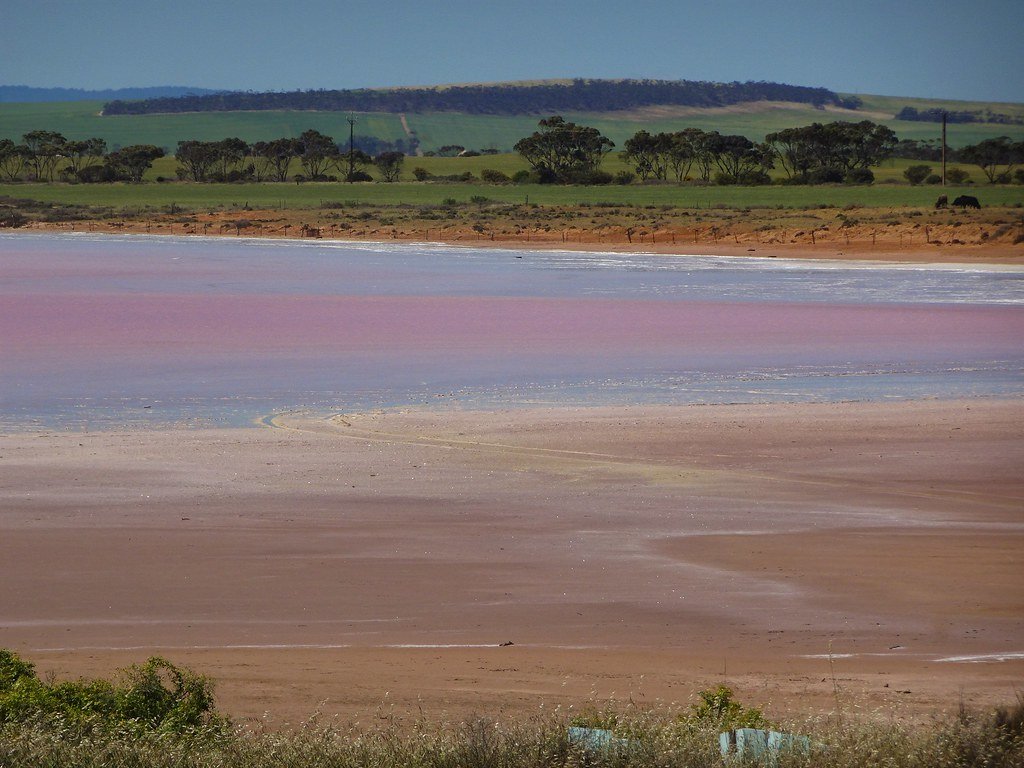
Long before European explorers “discovered” Lake Hillier, the local Noongar Aboriginal people incorporated this pink wonder into their cultural traditions and spiritual practices. The lake held special significance as a place where the physical and spiritual worlds intersected, where the ancestors had painted the water with colors from the sky. These oral traditions provided a cultural framework for understanding this natural phenomenon that predated scientific explanations by thousands of years.
Traditional Aboriginal knowledge about Lake Hillier includes detailed observations about the lake’s behavior, its relationship with surrounding ecosystems, and its role in the broader landscape. This indigenous wisdom complements modern scientific research and provides valuable insights that might otherwise be overlooked by conventional study methods.
Today, collaboration between Aboriginal traditional custodians and modern scientists creates a more complete understanding of Lake Hillier’s significance. This partnership respects both cultural heritage and scientific inquiry, ensuring that research proceeds in ways that honor the lake’s deeper cultural meanings while advancing our scientific knowledge.
Potential Threats to This Natural Wonder

Climate change poses the most significant long-term threat to Lake Hillier’s pink persistence. Rising temperatures could alter the delicate balance of microorganisms that create the lake’s color, while changing rainfall patterns might dilute the salt concentrations that these extremophile bacteria require to survive. Even small shifts in temperature or salinity could trigger cascading effects throughout the lake’s ecosystem.
Ocean level rise presents another concern, as it could potentially flood the narrow strip of land that separates Lake Hillier from the Southern Ocean. If seawater regularly mixed with the lake’s contents, it might disrupt the chemical balance that has remained stable for centuries. This threat becomes more pressing as global warming accelerates ice cap melting and thermal expansion of ocean water.
Human activities, though carefully controlled, still represent potential risks. Air pollution, boat emissions, and even the electromagnetic fields from research equipment could theoretically affect the sensitive organisms that maintain the lake’s pink color. Every human interaction with this ecosystem requires careful consideration of potential consequences.
Commercial Applications of Pink Lake Bacteria

The extremophile bacteria that create Lake Hillier’s pink color have attracted attention from biotechnology companies interested in their unique properties. These organisms produce natural pigments that could potentially replace synthetic dyes in food, cosmetics, and textile industries. Their ability to thrive in harsh conditions also makes them valuable for developing new industrial processes that operate in extreme environments.
Medical researchers are particularly interested in the DNA repair mechanisms these bacteria have evolved to survive intense radiation exposure. Understanding how these organisms fix genetic damage could lead to new treatments for cancer or improved protection for astronauts traveling to Mars. It’s remarkable that bacteria from a pink lake in Australia might someday help humans explore space.
However, any commercial exploitation of Lake Hillier’s organisms must be balanced against conservation concerns. Harvesting bacteria from the lake could disrupt its ecological balance, potentially destroying the very phenomenon that makes these organisms valuable. Researchers are working on laboratory cultivation methods that could provide commercial quantities without disturbing the natural ecosystem.
Comparing Lake Hillier to Other Natural Color Phenomena

Lake Hillier belongs to an exclusive club of natural color phenomena that seem almost too spectacular to be real. Like the Northern Lights, bioluminescent beaches, or rainbow eucalyptus trees, it represents nature’s ability to create beauty that surpasses human imagination. However, unlike many other colorful natural displays, Lake Hillier’s pink water is permanent rather than ephemeral.
The Grand Prismatic Spring in Yellowstone creates rainbow rings through heat-loving bacteria, but its colors shift with seasonal temperature changes. Brazil’s Lagoa Vermelha can turn blood-red during certain conditions, but it spends most of the year looking ordinary. Lake Hillier stands alone in maintaining its shocking color regardless of external conditions.
What makes Lake Hillier particularly special is its accessibility to aerial observation. While many natural color phenomena require specific timing, weather conditions, or remote locations to witness, Lake Hillier’s pink beauty is available for viewing year-round from scenic flights. It’s nature’s most reliable color show, performing the same spectacular display every single day.
The Future of Lake Hillier Research

Advanced genetic sequencing technologies are revolutionizing our understanding of Lake Hillier’s microbial communities. Scientists can now identify and study organisms at the molecular level, revealing complex interactions between different species that create the stable pink ecosystem. Future research will likely uncover even more sophisticated biological mechanisms at work in this natural laboratory.
Satellite monitoring and remote sensing technologies allow researchers to study Lake Hillier without physically disturbing its ecosystem. These tools can track changes in color intensity, surface temperature, and chemical composition over time, providing valuable data about how the lake responds to environmental variations. This non-invasive approach protects the lake while advancing scientific knowledge.
International collaboration between research institutions is expanding our understanding of extremophile ecosystems worldwide. Lake Hillier serves as a reference point for studying similar environments on other continents and potentially even other planets. The organisms that create its pink color might help us understand how life could exist in the harsh conditions found on Mars or Europa.
Photography and Artistic Inspiration

Lake Hillier has become one of the world’s most photographed natural wonders, inspiring countless artists, photographers, and filmmakers to capture its otherworldly beauty. The challenge lies in accurately representing the lake’s true colors, as many cameras and printing technologies struggle to reproduce the intensity of its bubblegum-pink hue. Professional photographers often find that their images either oversaturate the color into artificial-looking magenta or undersaturate it into disappointing pale pink.
The lake’s visual impact has influenced contemporary art, fashion, and design worldwide. Its specific shade of pink has been recreated in everything from haute couture collections to architectural projects, bringing a piece of this natural wonder into human-created environments. Interior designers frequently reference “Lake Hillier pink” when seeking to create spaces that evoke wonder and surprise.
Time-lapse photography of Lake Hillier reveals subtle changes in color intensity throughout the day as lighting conditions shift. While the pink remains constant, the way it interacts with sunlight, shadows, and reflections creates an ever-changing masterpiece that looks different from moment to moment while maintaining its essential character.
Lessons from Nature’s Color Laboratory
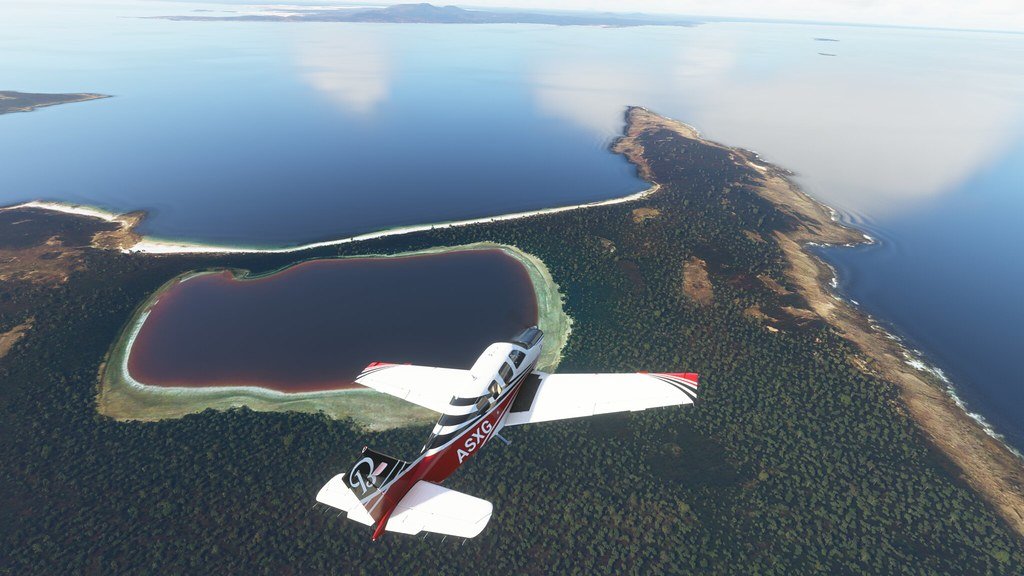
Lake Hillier teaches us that nature’s solutions to survival challenges often involve beauty as a byproduct. The bacteria that create the lake’s pink color didn’t evolve their pigments for aesthetic purposes – they developed them as practical tools for energy harvesting and radiation protection. Yet the result is one of Earth’s most stunning natural displays, proving that functionality and beauty aren’t mutually exclusive in nature’s designs.
The lake also demonstrates the importance of balance in ecosystems. Its stable pink color results from countless biological and chemical processes working in perfect harmony. Small changes in any component – temperature, salinity, bacterial populations, or mineral content – could potentially disrupt this balance and change the lake’s appearance forever.
Perhaps most importantly, Lake Hillier reminds us that our planet still holds mysteries waiting to be solved. Despite decades of research, scientists don’t fully understand all the mechanisms that maintain its pink stability. In an age when we can map genes and explore space, a small lake in Australia continues to guard some of its secrets, inspiring continued research and wonder.
Conclusion: A Pink Puzzle That Continues to Captivate
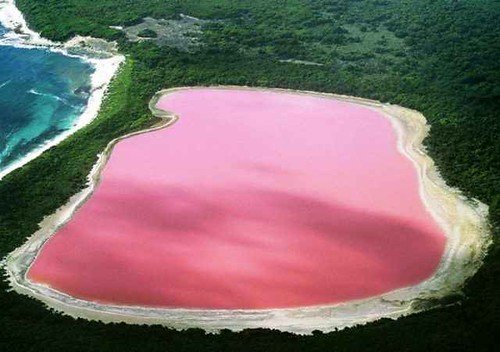
Lake Hillier stands as one of nature’s most persistent mysteries, a bubblegum-pink reminder that our planet still has the power to surprise us. This small body of water on a remote Australian island challenges our understanding of aquatic ecosystems while serving as a living

